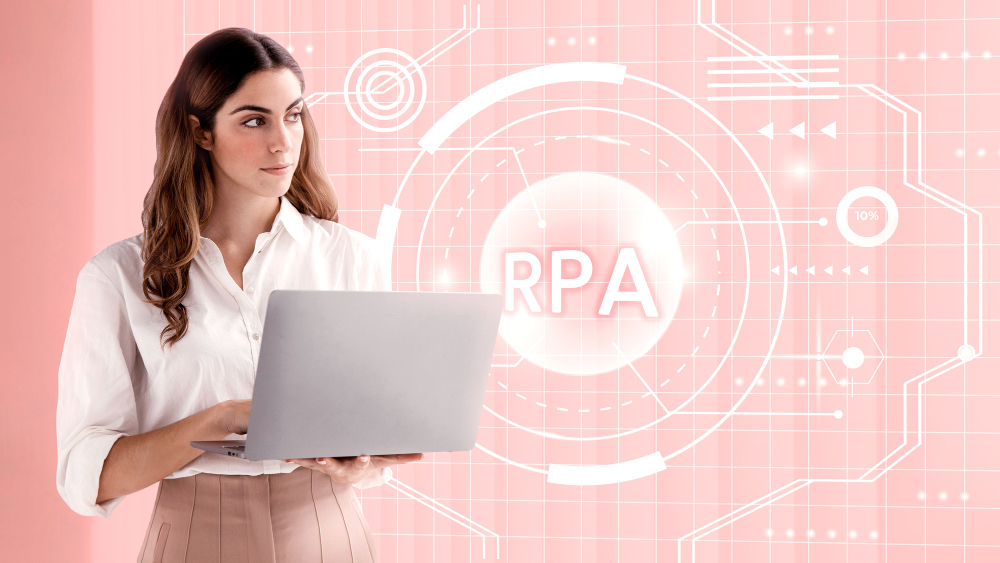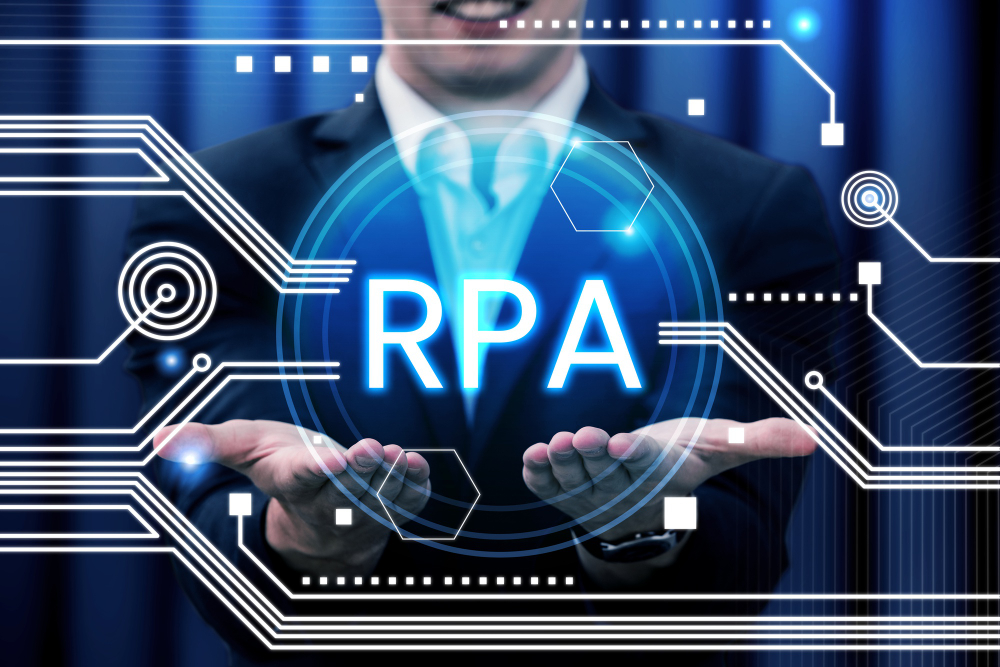
Key Takeaways
- Enterprise Architecture refers to a conceptual design that outlines the structure and operations of an organization. It helps build a roadmap for the organization to achieve its current and future objectives.
- EA is a critical component in the digital transformation journey of an organization because it provides a holistic view of the processes, systems, and technologies. This helps to align the infrastructure with the strategic goals of the organization.
- AI (Artificial Intelligence) is integrated into EA to build robust frameworks that foster agility and innovation.
- AI offers several enhancements to EA and helps businesses transition from the traditional reactive mode to a proactive, agile approach.
- Choosing the right software and structured deployment of AI in EA can be time-consuming and complicated. It can be simplified by working with an automation partner like Auxiliobits.
- Embedding AI in EA frameworks helps businesses keep pace with technological advancements and provides a competitive edge.
EA (Enterprise Architecture) lays the foundation for a seamless digital transformation of a business. The EA framework brings legacy applications and processes together to facilitate digital transformation.
- What is Enterprise Architecture?
- Evolution of EA
- Role of AI in Enterprise Architecture
- AI Use Cases in Enterprise Architecture
- How Enterprise Architects (EAs) can Leverage AI to Drive Structured Business Outcomes?
- Conclusion
What is Enterprise Architecture?
Enterprise Architecture refers to a conceptual design that outlines the structure and operations of an organization. It helps build a roadmap for the organization to achieve its current and future objectives. EA helps unify and coordinate departmental processes across the organization. It allows departments to comprehend the broader business model and work cohesively towards achieving business goals. The purpose of EA is to decipher complex business structures and align technology systems with them to optimize processes and drive innovation.
EA has witnessed remarkable growth recently as businesses strive to align their IT infrastructure with their organizational strategies. The EA market is expected to grow from $1.15 billion in 2023 to $1.7 billion by 2030 (Source: Medium).
Evolution of EA
Enterprise Architecture made its presence in the 1950s and 60s. However, it became a specialized field in the 1980s when computers took center stage. At that stage, it was considered a support function. EA was developed with the help of static models, graphs, charts, etc. Enterprise architects would create visualizations and diagrams to create a framework. However, early EA frameworks did not focus on data.
EA involves conducting impact analysis, scenario comparison, or analysis of the propagation of incidents within the company’s structure. However since a business is a complex, non-linear system involving multiple variables, it is difficult to model the equations of its behavior and rules that govern its evolution. This was difficult for traditional EA systems. And, emerging technologies like RPA, AI, etc., started making inroads in EA.
Fast forward to 2024!
Businesses need to keep pace with changing customer preferences and growing demands. Besides, they need to adopt new tools and technologies to boost efficiency. Another important factor is the growing focus on leveraging data for better decision-making.
Integrating digital technologies or digital transformation has become imperative for businesses to thrive in a dynamic marketplace. As companies embark on digital transformation journeys for enhanced efficiencies, EA provides a holistic view of the processes, systems, and technologies.
EA has a critical role to play in facilitating the integration of digital technologies. It helps to prepare a roadmap for the implementation of digital technologies while also optimizing operations and aligning IT and business goals.
EA has evolved to stay relevant to the current context. EA outputs and inputs are now democratized instead of remaining the IT prerogative. The EA data is now available to decision-makers across the organization. It no longer has framework-constrained rigid architecture but delivers contextual intelligence for faster decision-making. Businesses develop EA frameworks not only to support robust operations but also to guard against cyber threats and adhere to data protection regulations.
Modern-day enterprise architecture includes enhancements like platform functionality, visualizations via rendering layouts, reconfigurability, and more. EA tools provide real-time, contextual insights through intuitive interfaces that make data easily accessible to various stakeholders.
Enterprise Architecture, now, includes real-time augmented intelligence across the enterprise and the ecosystem in which it operates. It provides contextually enriched crowdsourced data. It enhances operational efficiency and strategic agility.
As businesses become more complex, the enhancements in EA frameworks are required to support their growing needs while making them agile and resilient.
Enter AI (Artificial Intelligence)!
Artificial Intelligence has revolutionized different facets of businesses across sectors. AI boosts efficiency by automating processes. It helps optimize workflows by making accurate forecasts while providing valuable insights for data-based decision-making. Generative AI (a subset of AI) further enhances the intelligence of automated systems by fostering human-like interactions, creating simulated environments, generating content, and more.
AI has a vital role to play in Enterprise Architecture as well!
AI can be applied at the initial stages of developing the EA framework. AI tools analyze vast datasets quickly and efficiently to identify areas of improvement. A precise understanding of these areas helps businesses build robust EA frameworks that are tailored according to the specific needs of the organization.
AI algorithms leverage advanced data analytics techniques to identify patterns and trends. These insights enable Enterprise Architects to develop informed and effective strategies.
AI facilitates faster decision-making by providing Enterprise Architects insights based on real-time, multi-source data analysis.
NLP (Natural Language Processing) tools analyze unstructured data from multiple data sources such as internal communications, maintenance logs, etc., to identify key insights and trends.
AI-based chatbots in EA handle routine queries from stakeholders freeing up the time of enterprise architects who can focus on more skilled tasks.
GenAI focused tools streamline the documentation and report generation process by creating human-like reports/documents.
AI tools can identify and anticipate potential issues that can impede the success of a project. For instance, they can identify risks and dependencies that impact project timelines, budget, or scope. These insights help Enterprise Architects mitigate risks effectively.
AI in EA also helps to evaluate different scenarios and predict their impact on the organization.
AI Use Cases in Enterprise Architecture
- Image Modeling
AI tools enable you to photograph drawings and convert them into structured models instantly. These models may represent processes, data, application structures, and more. Modeling unstructured data such as drawings, etc., makes it easier to analyze it.
- Transformation of Models
Models are built to represent reality for specific applications. The dual mechanism of graph transformation works with AI to offer opinions that meet the concerns of multiple users in the company.
- Seamless Communication
Often companies need to communicate in different languages internally. There may be an official language supplemented by native languages of various communities. NLP techniques facilitate instant or machine translations that help build a multilingual repository. This paves the way for seamless internal communication and alignment.
- NLP Techniques
NLP facilitates the semantic analysis of a question and its approximation to information from a frame of reference. The software provides results via queries and reports which makes it easy for all employees to reference and understand the operations and structure and contribute to the transformation model.
- Normalization of Data
EA systems gather data from multiple sources. However, this data may be prone to inaccuracies and errors such as duplication, redundant data, typos, etc. These inaccuracies make it difficult to extract relevant information from vast datasets. AI tools extract a clean consolidated view and put it into perspective. Data normalization helps to reconcile terms and present data summaries that are precise and relevant.
- Risk Analysis
AI tools gather operational data from projects alongside architectural data. They provide details like scale, domain, complexity, ramifications, technology, scale of transformation, and more. This information makes it easier to predict the level of risk in the digital transformation process.
- Agility at Scale
Cloud tools host vast volumes of metadata. The semantic analysis of metadata and its reconciliation with the information in the repository facilitates collaboration between teams in charge of operations and those in charge of new development and continuous transformation which facilitates agility at scale.
How Can Enterprise Architects Leverage AI to Drive Structured Business Outcomes?

- Strategic Alignment:
AI is leveraged to analyze vast volumes of data from both internal and external sources to gain insights into market trends, customer behaviors, competitive landscapes, and more. These insights enable Enterprise Architects to align IT strategies with business goals more effectively.
- Decision Support:
AI facilitates informed decision-making by providing predictive analytics and scenario modeling. For instance, AI algorithms can forecast the impact of different architectural decisions on business outcomes, enabling Enterprise Architects to choose the most effective strategies.
- Automated Design and Optimization:
AI-powered tools can automate the design and optimization of enterprise architectures. This includes generating architectural patterns, evaluating trade-offs, and recommending improvements based on performance metrics and business objectives.
- Risk Management:
AI helps to identify and mitigate risks associated with architectural decisions. AI algorithms can detect potential risks and vulnerabilities in systems or processes and recommend preventive measures to enhance security and resilience.
- Enhanced Customer Experience:
AI technologies like NLP and ML help design architectures that improve customer interaction and satisfaction. Chatbots, personalized recommendations, and sentiment analysis are examples of AI applications that can enhance customer experience.
- Operational Efficiency:
AI streamlines operations by automating repetitive tasks, optimizing resource allocation, and improving workflows. Enterprise architectures can be designed to integrate AI-driven automation to reduce costs and improve efficiency across the organization.
- Real-Time Adaptation:
AI-powered analytics and monitoring systems, continuously monitor performance metrics and business KPIs in real time. This facilitates agile decision-making. It also makes the architectures adaptable to changing business conditions.
- Ethical and Regulatory Compliance:
AI ensures enterprise architectures comply with ethical standards and regulatory requirements. AI tools can analyze data handling practices, detect biases, and provide frameworks for responsible AI implementation.
- Collaborative Ecosystems:
AI can be leveraged to foster collaboration across diverse teams and stakeholders. AI-powered platforms can facilitate communication, knowledge sharing, and consensus building among architects, developers, and business leaders.
- Continuous Learning and Adaptation:
AI technologies help to implement architectures that can learn from data and adapt over time. This includes deploying AI-driven systems that improve performance based on user feedback and evolving business needs.
Integrating AI into Enterprise Architecture helps businesses stay at the forefront of innovation and fosters continuous evolution and improvement. It enables companies to transition from the traditional reactive mode to a proactive, agile approach that anticipates and leads market trends.
The integration of AI into existing EA frameworks begins with the evaluation of existing frameworks to identify the areas of AI integration. You must then choose the best AI tools and embed them in the existing frameworks. The EA market offers a wide range of tools, frameworks, and methodologies that help businesses manage their IT infrastructure and align it with their business goals effectively. It involves meticulous planning, designing, and implementation of a structured approach. Additionally, you need to be aware of the potential risks in implementing AI and mitigate those risks. Ensuring regulatory compliance is another area to focus on while integrating AI in EA. Besides these, there are several other aspects to consider while implementing AI.
Choosing the right software and structured deployment of AI in EA can be time-consuming and complicated. It can be simplified by working with an automation partner like Auxiliobits.
Our professional team understands the technological landscape and has the expertise to navigate it. We work closely with our clients to understand the specific needs of their business. Our experts help you identify the areas where AI can be integrated to enhance efficiencies. We help you to choose the best AI software that can be customized according to the needs of your business. We support our clients through end-to-end implementation and maintenance. We also provide training and education support to your in-house teams.
Conclusion
Integrating AI in Enterprise Architecture marks a significant shift in how businesses leverage technology to enhance operational efficiency and strategic alignment. It can establish new standards for business operations across sectors. Embedding AI in EA frameworks helps an organization keep pace with technological advancements. It also provides a competitive edge by ensuring an IT infrastructure that is scalable, adaptable, and can promptly respond to changing business environments.
If you are considering building robust Enterprise Architecture for your business, connect with the experts at Auxiliobits!





